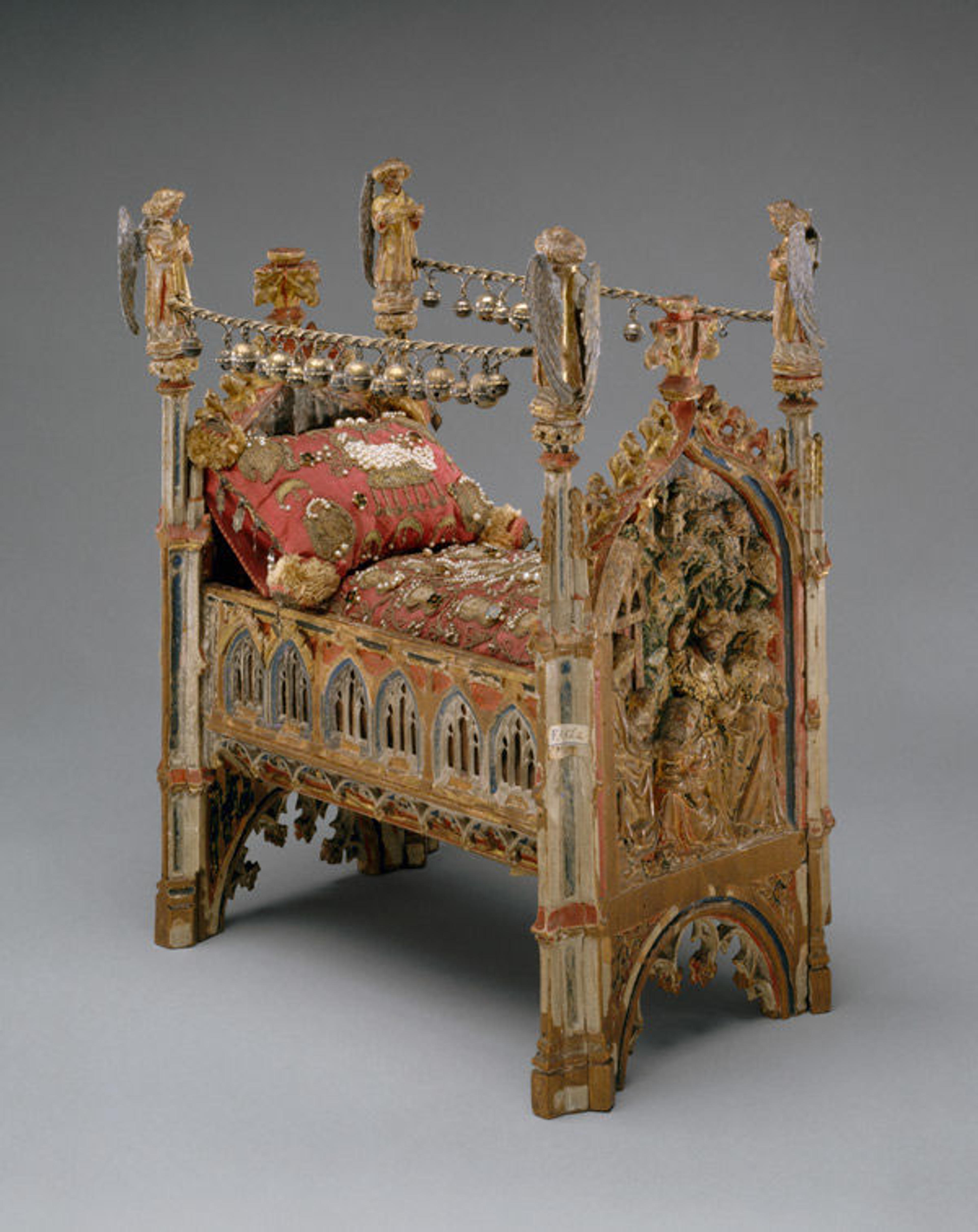One in Over Two Million
In honor of World Teachers' Day on October 5, the Teen Blog is pleased to present a post written by an educator and recent graduate intern about her favorite work in the Museum's collection.

Crib of the Infant Jesus, 15th century. South Netherlandish. Wood, polychromy, lead, silver-gilt, painted parchment, silk embroidery with seed pearls, gold thread, translucent enamels. The Metropolitan Museum of Art, New York, Gift of Ruth Blumka, in memory of Leopold Blumka, 1974 (1974.121a–d)
«From the more than two million works in the Met's permanent collection, one tiny object has held me captive ever since I first laid eyes on it. I started my graduate internship in the Education Department in late January of this year, and as I made my way through the Museum throughout my internship—selecting artworks for programs and supporting events, ambling from the mailroom to the Petrie Court, and exploring the galleries of African, Asian, and medieval art—the Crib of the Infant Jesus always managed to stop me in my tracks, demanding at least a few good minutes of contemplation each time.»
Part of my experience within the Education Department was sharpening and honing my ability to create ways for people, particularly teens and families, to engage with works of art. One of the key elements I focus on in my work is finding the thread that, when slipped through the needle and passed from person to person, weaves a story that each participant engaged in a dialogue around the original work helps to construct. My role is not only to open these portals but also, when appropriate, to drop in bits of content, context, or facts about the work of art that supports observations. I am ashamed to admit that oftentimes when I walked through the galleries on a mission, I was so focused on the one particular piece with which I was due to "teach," that many other works of art fell away. Yet, still today, every time I walk by the miniature cradle, the experience is different.
Delicately carved and intricately painted scenes, including the Nativity and the Adoration of the Magi, decorate the headboard and footboard, and the biblical family tree of Christ is embroidered in the finest silk of the coverlet, with gilded silver and gold thread, seed pearls, and translucent enamel that twinkles brightly like a star when the light hits it. Elaborately trimmed, deep-burgundy silk pillows stand tall and inviting—a resting place fit for a prince. A perch, high atop Gothic arches and shadows that are cast hauntingly below the raised bed, is guarded at each of its four posts by an angel standing vigil. Streams of bells, tiny and tinier, run between the posts. Are they there to make a lulling, soothing sound? Or to protect, perhaps a warning of approaching spirits? Small holes burrowed into the middle top of each bed board seem a perfect place to put a thin candle.
Exploring the object at great length, I ask myself the questions I might use to engage a group, and through observation and inquiry, I begin to piece together important details that help me build a story. This elaborate crib is indeed too small for a real baby, but it is so richly and lovingly adorned that it must certainly be for someone very special. Adding up the clues and unanswered questions, I then refer to the label and discover that, indeed, this crib was created for the infant Jesus, but purely as as a devotional object—presented to women taking their vows in a convent in Louvain, Belgium, during the fifteenth through sixteenth century.
But I don't stop there, I can't stop there. I want to know more! I want to imagine what it was like to be that soon-to-be nun, devoted day and night to the life of an infant child, believing so certainly in the importance of his calling and intended purpose in serving humankind. What did her room look like? How did she imagine the infant resting safely in his crib? How often did she pray? How did she use this object in her ritual, and what prayers did she say?
With that, the final part of my role within museum education is clearly illustrated: I am here not necessarily to answer all the questions, but to instill a hunger and passion and desire to imagine a world of infinite possibility; to promote the practice of inquiry; and to support the active engagement in one's own learning through works of art. To give time willingly to decoding objects, listening and following the clues they contribute in order to collectively create and breathe life into the stories they tell for all those willing to share in the exchange.
The Crib of the Infant Jesus is in Gallery 306 in the Department of Medieval Art and The Cloisters. I dare you to walk by it without stopping to look, listen, and feel. Create your own story relevant to your life, and, in turn, connect with another time, place, and people.
Kendra undefined
Kendra was formerly a graduate intern in the Education Department.